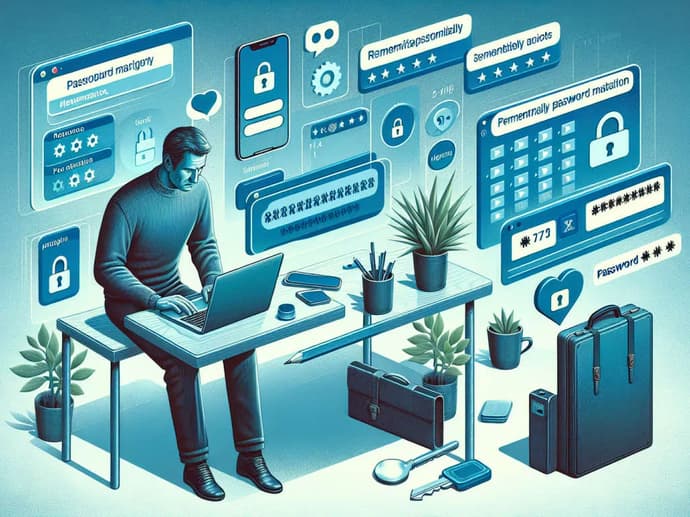
Password management: How do you protect your login details?

In today's online world, we do most of our daily activities and errands online. Whether it's a game that requires going through a Vulkan Vegas login, an online shop or official matters dealt with via online banking - you always have to enter your account details first.
The average web user has accounts on dozens of websites. It is virtually impossible to remember them all, so shortcuts are increasingly being taken. Despite the fact that everyone knows that this is not responsible, they use the same login data across multiple portals. Nowadays, you can use a variety of tools and ways to make password management easier, so you can permanently get rid of bad habits and effectively secure your accounts.
A strong password is essential
To effectively protect your online accounts, it is a good idea to start with a strong password that is impossible for outsiders to guess. Cyber security experts warn that the majority of hacks, come from inadequate account access security. Here are some of the most important things to look out for when setting up an account:
| Avoid simple strings | It is very common to take shortcuts by creating strings of characters that are easy for outsiders to remember (and guess), e.g. "password", "123456", "qwerty". |
| Use character combinations | Use not only words, but also numbers, uppercase and special characters. The more complex, the lower the chance of cracking the password. |
| Try to develop long passwords | The longer the password, the lower the likelihood of it being cracked - even by high-end tools. Come up with passwords that are at least 10 characters long. |
| Don't add personal information to passwords | Your date of birth, your child's name, your dog's, cat's or loved one's name or address are the first information checked by potential burglars. |
Use password managers
Remembering even several different login details can be difficult. So how do you remember dozens of different passwords - just as the experts recommend? It is no longer necessary to remember them all. Specialised software can help. Nowadays, every popular Internet browser has its own built-in password manager, which will effectively assist in logging in to various Internet services.
What is a password manager? It is a relatively simple tool that stores a database of all a person's passwords in a specially designed encrypted infrastructure. All you need to do is remember your login details for the manager and you will manage to access all the data stored in it.
Benefits of using the password manager:
- Security: Login data is protected in a secure area, often with two-step login verification security.
- Convenience of use: The password manager not only automatically stores your login data, but also allows autocomplete. This way, all you have to do is go to the chosen service and use the autocomplete option, then confirm your login.
- Manager synchronisation: If someone uses multiple devices - for example, computers and a smartphone - the password manager can be synchronised between these devices, providing constant access to all saved login data.
Those who choose to use a password manager at least once will certainly not want to go back to the days of saving data in various files or on paper.
Changing passwords regularly is very important
Passwords can leak. Even if the user takes proper care of all the necessary layers of protection, a leak can occur on the part of the service where the account is registered. This is when hackers usually receive the email address and password. If the same data are used for an e-mail box, for example, it is a very easy way for a burglar to gain access to all the accounts registered on it.
This is why it is a good idea to modify your passwords regularly. It is difficult to clearly define how often this should be done, but experts claim that once every six months is sufficient. Of course, it is difficult to talk about changing dozens of passwords on different accounts here. Therefore, this rule mainly applies to all those who use one password creation system or (which is highly not recommended) use one string for most of their accounts. After such a change, if there is a leak of passwords from a long-unused service, security can be assured.
Two-Factor Authentication (2FA)
This is one of the strongest account security measures used by most financial institutions. If your chosen service offers the option to enable two-step login, it is always a good idea to use this option. The login may require 10 extra seconds for verification, but the security is absolute.
For example, if someone is given access to a login and password on a particular service and enters the correct login information, an additional security message will appear asking for verification on a mobile device, for example. This could be a special app to validate, an email/SMS message with a code to transcribe.
If an account is secured in this way, you can be sure that nothing bad can happen to such an account.
Awareness of the risks is just as important as the security features themselves.
You can use the most modern forms of securing your login data, but the first and most important layer of protection is ourselves. If we choose not to protect our data, no one will do it for us. This is why everyone should be aware of the dangers online. Keyloggers, spyware or modern AI phishing methods. It is worth being aware of all the risks and never, under any circumstances, share your login data with any third party.

Elen Stelmakh on luova henkilö, joka on omistautunut edistämään pelikulttuuria artikkeleiden ja visuaalisen suunnittelun avulla. Päätoimisena EGamersWorldin kirjoittajana ja pelisivuston suunnittelijana Elen ei ainoastaan luo sisältöä, vaan myös antaa sille energiaa ja luovuutta.
 Steal a Brainrot Winter Hour Tapahtuman tiedotLöydä kaikki Roblox Steal a Brainrot Winter Hour Event - New Christams Brainrotit ja palkinnot.
Steal a Brainrot Winter Hour Tapahtuman tiedotLöydä kaikki Roblox Steal a Brainrot Winter Hour Event - New Christams Brainrotit ja palkinnot. Tässä on Fortnite Chapter 7 Kaikki hahmot ja niiden sijainnitFortnite Chapter 7 Kaikki hahmot ovat levittäytyneet Golden Coast -kartalle, ja ne tarjoavat palveluita, palkkausvaihtoehtoja ja tehtäviä, jotka muokkaavat jokaista ottelua avauskaudella.
Tässä on Fortnite Chapter 7 Kaikki hahmot ja niiden sijainnitFortnite Chapter 7 Kaikki hahmot ovat levittäytyneet Golden Coast -kartalle, ja ne tarjoavat palveluita, palkkausvaihtoehtoja ja tehtäviä, jotka muokkaavat jokaista ottelua avauskaudella. Mystbloom 2.0 Paketin tiedot: Pelin ulkoasu: Kaikki nahat, hinta, julkaisupäivä, pelin ulkoasu.Mystbloom 2.0 jatkaa kukka- / "bloom"-teemaa, säilyttäen terälehtimäiset muodot ja kausiluonteisen väripaletin, jotka määrittelivät ensimmäisen malliston.
Mystbloom 2.0 Paketin tiedot: Pelin ulkoasu: Kaikki nahat, hinta, julkaisupäivä, pelin ulkoasu.Mystbloom 2.0 jatkaa kukka- / "bloom"-teemaa, säilyttäen terälehtimäiset muodot ja kausiluonteisen väripaletin, jotka määrittelivät ensimmäisen malliston. Dota 2 DreamLeague Kausi 27 YleiskatsausTutustu kaikkeen DreamLeague Season 27:stä: aikataulu, formaatti, osallistuvat joukkueet ja 1 000 000 dollarin palkintopotti.
Dota 2 DreamLeague Kausi 27 YleiskatsausTutustu kaikkeen DreamLeague Season 27:stä: aikataulu, formaatti, osallistuvat joukkueet ja 1 000 000 dollarin palkintopotti.


